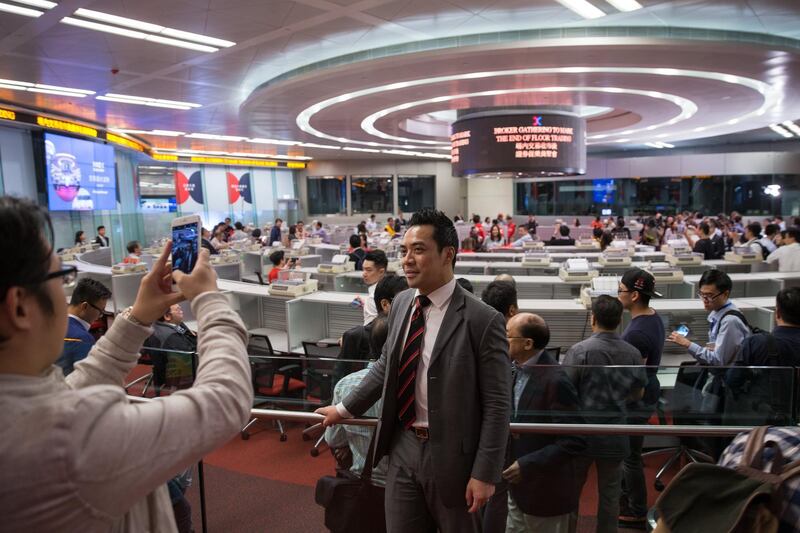Hong Kong Exchanges & Clearing is about to become the newest member of a once unthinkable club: stock exchanges without a trading floor.
HKEX will shut its iconic Trading Hall on Friday, 31 years after opening the space in the heart of the city’s financial district. While it survived longer than counterparts in Singapore and Tokyo, Hong Kong’s floor had become increasingly irrelevant amid the rise of electronic trading. The last time HKEX bothered to publish figures in 2014, floor transactions comprised just 0.2 per cent of total turnover.
The closing has been met with a mix of resignation and nostalgia by local traders, some of whom spent the bulk of their working lives in the space, shouting orders through the 1987 crash, the dot-com bubble, the Sars outbreak and countless other booms and busts. As the digital revolution pushed more and more trades from humans to computers, the floor got quieter and quieter: daily attendance dwindled to about 30 recently from 600 in 2000.
“I’m going to miss the Trading Hall a lot,” said Catherina Lai, a director of the securities unit at Mason Group. She’s been working in the brokerage industry since 1985 and was one of the Hong Kong Stock Exchange’s first floor traders. “I sat near the hallway, so a lot of people came over and asked me about the market.”
Floor trading first began in Hong Kong in 1891, while the current hall – located at Exchange Square – has been open since 1986 when four bourses combined to form the Hong Kong Stock Exchange.
The property belongs to the Hong Kong government, which collects rent from HKEX, at HK$3.58 million (Dh1.6m) per year, unchanged since 2008.
The vast floor area covers 45,000 square feet, and there are 906 two-person booths, which at their peak were daily homes to some 1,400 traders in the 1980s.
Herding all the city’s brokers under one roof helped bring a sense of order to what had been a chaotic market, said Christopher Cheung, the chairman of Christfund Securities and a former member of Hong Kong’s Far East Stock Exchange. Before the merger, shares would sometimes trade at different prices from one venue to the next, he said.
“When there were four exchanges, everyone was trading separately and didn’t know what other people were doing,” said Mr Cheung, who is also a policymaker representing brokerages. “With the integrated trading floor, the vibe made people more actively participate.”
______________
Read more:
HKEX chief says key to winning Saudi Aramco is primary connect
Index majors set to lock horns over stock exchanges
Exclusive: Saudi Arabia’s Tadawul open to stake sale to international exchanges
______________
A year after its opening, the floor played host to one of Hong Kong’s biggest market collapses. The rout began with an 11 per cent drop in the benchmark Hang Seng Index on October 19, 1987 - later known as Black Monday - and accelerated the following week despite the exchange’s decision to shut for four days. It took almost four years for the gauge to reclaim its pre-crash high.
“It was the darkest day in the Trading Hall,” Ms Lai said. “Once the market reopened, everyone was selling. Nobody knew when the market would go back to normal.”
The floor’s steady decline into irrelevance began in 1996, when the first off-site order was sent.
Technological improvements did more than just change brokers’ physical locations; they also automated some of the most tedious aspects of the job. Before trading went paperless, Ms Lai said she used to spend hours on menial work, like gluing pre-paid stamps (for the city’s stamp duty) on share transfer forms.
While trading floors are increasingly rare these days, some markets have resisted the temptation to go completely electronic. The New York Stock Exchange still has its floor at 11 Wall Street, where the opening bell is a fixture of business television every weekday morning. BOX Options Exchange, which is about 40 per cent owned by Toronto-based TMX Group, won approval in August to open a trading floor in Chicago. BOX says face-to-face dealing helps derivatives traders get a better view of pricing and liquidity.
In Hong Kong, the shift away from humans may accelerate. HKEX is considering asking the government to remove or reduce the city’s stamp duty on stock transactions, according to a person familiar with the bourse’s thinking, a move that could attract more algorithmic and high-frequency traders.
As for the old trading floor, HKEX plans to use the space to bring the city’s financial community together. After a renovation, it will host conferences, exhibitions and ceremonies, according to an exchange spokesman. There may also be a small history section for visitors to see how the floor looked in its glory days.
“Some people say Hong Kong’s big time is behind us, but it isn’t,” HKEX’s chief executive Charles Li said at an event to mark the closing.
“It may have ended for this place as a trading hall, but a new big time, a much bigger one, has just started.”






